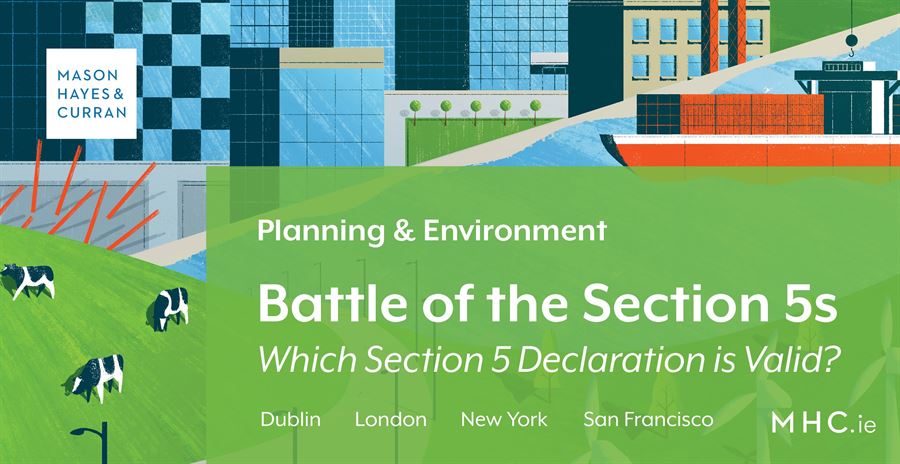Planning & Environment Update: Battle of the Section 5s - Which Section 5 Declaration is Valid?

Clarity on the status of parallel section 5 declarations has been given in the recent case Narconon Trust v An Bord Pleanála [2020] IEHC 25 dated 24 January 2020 (the Case). This Case concerns a section 5 declaration (the Declaration) under the Planning and Development Act 2000 (as amended) stating that a development is or is not exempt from obtaining planning permission.
Clarity is now given where an initial decision on exemption is made and a subsequent referral gets a contrary decision for the same development. This Case holds that An Bord Pleanála (the Board) is not allowed deal with subsequent section 5 referrals in certain circumstances. These circumstances are where:
-
There is a prior, valid unappealed Declaration made by a local planning authority in accordance with a separate reference, if the relevant planning facts or circumstances have not changed between the issuing of the local authority’s Declaration and the subsequent referral.
Facts of the case
This Case concerns an application for judicial review brought by the applicant, Narconon Trust under s. 50 of the Act. The applicant sought judicial review of two decisions made by the Board. The Board concluded that the change of use from a nursing home to a residential drug rehabilitation facility at the former Old National School, Ballivor, Co. Meath is development and is not exempted development (i.e. the change of use requires planning permission). The Board’s decisions in 2018 were made after Meath County Council had already issued a Declaration two years earlier that the change of use from a nursing home to a residential drug treatment centre is development and is exempted development and as a result does not require planning permission.
Reasoning of Mr Justice Heslin
 Mr Justice Heslin found the following of particular assistance in making his decision in the Case.
Mr Justice Heslin found the following of particular assistance in making his decision in the Case.
In Killross Properties Limited v. ESB & Anor [2016] 1 IR 541 Mr Justice Hogan analysed the Supreme Court’s decision in Grianán an Aileach Centre v. Donegal County Council [2004] IESC 43, [2004] 2 I.R. 625. Judge Hogan stated the effect of this case was that the High Court is impliedly precluded from granting a form of declaration in enforcement proceedings that a development is exempt where a section 5 application for a certificate of exemption has been refused. To do otherwise would result in two contradictory official determinations of the question of whether the development was exempt or not.
Judge Heslin found that if it is permissible for the Board to issue a different decision in 2018, despite the existence of a valid and lawful declaration in 2016 about the same development without any change in planning facts or circumstances during the intervening period, the type of “confusion and uncertainty” referred to by Mr Justice Hogan in the above case is precisely what would arise.
In the Case, the original Declaration in 2016 could have been challenged by way of judicial review proceedings brought under s. 50 of the Act. No such proceedings were brought within the relevant time limit. In relying of this Declaration, the Applicant has spent approximately €9,050,000.00 on the facility at Ballivor, inclusive of the €1.3 million purchase price in reliance on the 2016 Council Declaration.
Judge Heslin noted that Ballivor Community Group and the Trim Municipal District Council were aware of the Council’s decision regarding the Declaration and did not judicially review the decision in the appropriate period. There was no evidence that Ballivor Community Group was operating under a genuine belief that there had been any change between 2016 and 2018 of relevant planning facts or circumstances.
Judge Heslin ruled that the Board did not have the power to make decisions in respect of what was in reality an attempt by the Ballivor Community Group and the Trim Municipal District Council to question the validity of the Council’s 2016 decision regarding the same circumstances. He stated that it would
“wholly undermine the concept of legal certainty and result in a patent unfairness if, despite having the benefit of a decision which was neither reviewed nor challenged in accordance with the mandatory route, including time limits, laid down by statute, a party could question the validity of the original decision, which they regarded as wrong, by asking the self-same question at some later point, ignoring the mandated route for a challenge to that decision, and in the context of unchanged facts, have that question answered differently.”
Judge Heslin granted an Order quashing the decision made by the Board that the change of use from a nursing home development to a residential drug rehabilitation facility at the former Old National School site in Ballivor, County Meath is development and is not exempted development. The original decision made by Meath County Council in issuing a Declaration that the project is a development and is exempted development stands.
What does this mean?
With this decision, projects can rely more securely on their Section 5 Declaration once the relevant planning facts or circumstances are unchanged without worrying about a further contrary section 5 Declaration being given for the same development. The only method of challenging a section 5 Declaration in these circumstances, and if all public participation requirements have been met, is in the normal judicial review procedure. This procedure must begin within eight weeks of the decision being reviewed. Once these eight weeks have passed, the Declaration is immune from challenge apart from in very limited circumstances.
Conclusion
With this decision, projects can rely more securely on their Section 5 Declaration once the relevant planning facts or circumstances are unchanged without worrying about a further contrary section 5 Declaration being given for the same development. The only method of challenging a section 5 Declaration in these circumstances, and if all public participation requirements have been met, is in the normal judicial review procedure. This procedure must begin within eight weeks of the decision being reviewed. Once these eight weeks have passed, the Declaration is immune from challenge apart from in very limited circumstances.
For more information about how this decision may affect your development, contact a member of our Planning & Environment team.
The content of this article is provided for information purposes only and does not constitute legal or other advice.
Share this:



